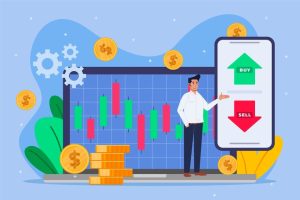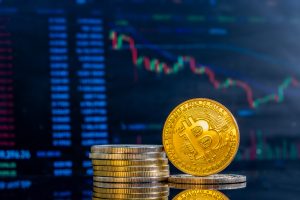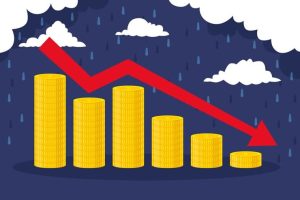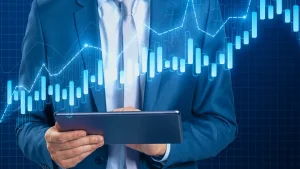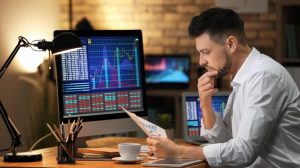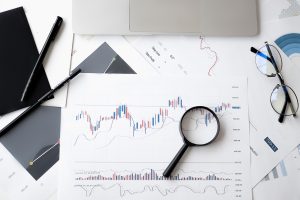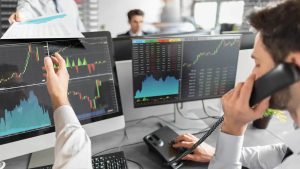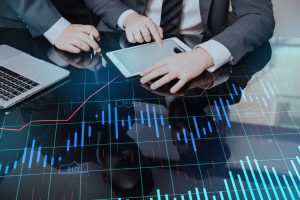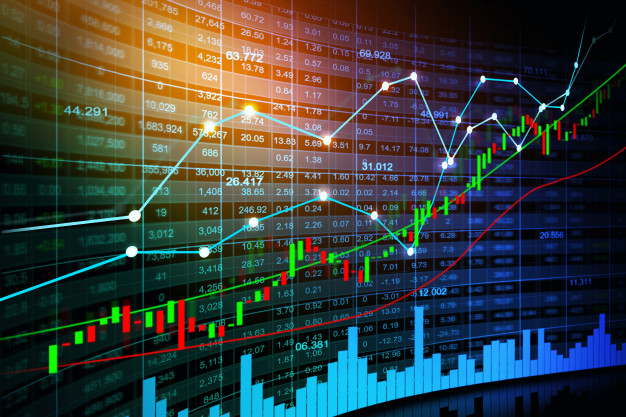
Introduction
If we think of a crowded market, pictures of bustling stock exchanges, with traders shouting buy and sell orders may appear in our minds. However, there’s an alternative market, a virtual one that’s a massive one that is bigger than stocks with respect to trading quantity that is The Forex market. It’s short for “foreign exchange”. Forex trading is the financial centre of the world as its volume per day surpasses a record $6 trillion. This article will go deep into the complexities involved in Forex trading by revealing its importance, how it works, as well as the potential it provides for traders.
In essence, Forex trading is the process of purchasing one currency, while selling a second. It operates as a decentralised marketplace, that is, there’s no central exchange, or location in which trades are conducted. It’s all electronics and businesses, banks and traders taking part from all over the world. This makes it a 24/7 market. Read More
You may be wondering how Forex trading is of such vital significance. A major reason for this is the function in helping facilitate international investment and trade. Imagine a scenario like this one example: A company based in the USA wants to buy electronics from Japan. As the American company makes its money dollars in US dollars (USD) and the Japanese producer would prefer to receive payment by the Japanese yen (JPY). That’s the point where Forex plays a role. In the Forex market, American companies will buy Japanese yen with their US dollars, thereby facilitating transactions. This process of conversion crucial to global business activities, is an evidence to the enduring value and the value of the Forex market.
However, in addition to aiding companies with their international endeavours and assisting them in their international ventures, the Forex market offers a world filled with possibilities for individual traders. Contrary to stock markets that depend on the individual performance of businesses however, Forex markets are influenced by the performance of individual companies. Forex market is driven by geopolitical, macroeconomic developments, the rate of interest among others. Forex traders study these variables and predict how they’ll affect the value of currencies. If they think that the US dollar is strengthening against the Japanese yen, as an example the USD/JPY pair could be bought. If their forecast is true then they could profit by the movement of the currency.
This article will take you deeper into the realm of Forex trading and will cover important issues such as:
- Trading Accounts: Getting to know the various kinds of accounts offered to traders. We will also highlight the distinctions between live and demo accounts.
- Trading Platforms: We will discuss what they’re about, what they are, and what makes them distinguish itself from the rest of the market.
- The Dynamics of Trading: Define trading as a whole by exploring the many trading kinds as well as introducing certain strategies used in the market.
- Beginning in Forex: Providing a plan for new traders beginning with education before stepping into real-time trading.
Controlled Forex Accounts Introduction LAMM, PAMM and MAM. We will shed light on the meaning of these accounts and what you can do to pick the right one among the three. - Forex Brokerage: Define brokerages and understand their purpose as well as guiding anyone who is interested in setting up their own brokerage.
At the end of this guide the readers will be armed with a complete comprehension of Forex trading as well as the necessary knowledge to navigate the complicated and vast seas. No matter if you’re a curious observer or a newbie trader or an experienced veteran it’s never too late to know about the evolving realm of Forex.
Trading Accounts
The field of Forex trading is extensive and varied, allowing traders of all levels, starting from beginners who are making their first venture into the world of finance to experienced veterans with decades of knowledge. The key to this flexibility lies in the various types of accounts which brokers provide. Each type of account is developed to satisfy the particular demands and needs of different traders. Learn about the specifics of these accounts to learn about their unique characteristics, advantages, as well as possible drawbacks.
1. Standard Account
The standard Account will be the most commonly used type of account provided by the majority of brokers. It is generally geared toward intermediate-level to advanced traders. Let’s take a look at:
Lots Size: A most important characteristic that differentiates a normal account is the size of its lot. When it comes to Forex trading”lot” refers to the amount of currency you’re trading “lot” signifies the amount of units in the currency you’re purchasing or selling. In a typical account, a”lot” typically is 100,000 units of base currency.
Who are they for? Because of the large volume of one lot on a normal account, this type of account requires greater capital expenditure. This type of account is typically most popular with traders who feel comfortable placing bets and putting at risk larger sums of money.
2. Mini Account
In order to move away from the regular account, we are now offering our Mini Account.
Lot Size: A mini’s amount of lot is 10,000 units, which includes base currency. It is one-tenth of the amount in the standard account.
What is it designed to be used for? Mini accounts are suitable for those who are new to trading or with a small trading capital. A smaller size of the lot means less risk and exposure, giving traders the chance to get an understanding of the market without having too much at risk.
3. Micro Account
To help those who want to start at a lower level and start with less, Micro Account is the best option. Micro Account is an ideal alternative.
Lot Size The lot size of only 1,000 units of base money, the micro account is a true reflection of its title.
What is the purpose of this account? This kind of account is great for people who are just beginning to dip their feet into the waters of Forex trading. With the minimum requirement for capital this account type is a great opportunity for beginners to try real trading without a lot of risk.
The differences between Demo as well as Live Accounts
Another important distinction to note that is crucial to note in Forex trading is that there are Demo live and demo accounts. Each is designed for a particular need and each has its own list of advantages and cons.
1. Demo Account
A Demo Account functions as an environment that traders can use as a sandbox.
The account type utilises virtual currency, which allows traders to try trading without the risk of real capital. All other aspects such as market conditions and prices, simulates the real trading atmosphere.
One of the biggest benefits of having the demo account is that it’s an opportunity to practise without risk. It allows traders to familiarise themselves with their trading platform, test out strategies and get familiar with market conditions without fearing loss.
Pros: Although demo trading is a valuable tool to training, demo accounts are often unable to recreate the psychological and emotional pressures that come with live trading. Real results and losses can trigger emotions that can affect trading choices – something that is not present from the demo trading.
2. Live Account
The real activity takes place on the Live Account.
Description: As its title suggests the live account is real cash. Every loss and profit directly affect the trading capital.
Possibilities for real profit is the principal attraction of having a live account. Furthermore, trading in a live atmosphere helps to build a trader’s emotional and emotional stability, which is an important aspect for the long-term viability of trading.
Pros: With real positive results comes real dangers. Investors could lose some or even all their capital which is why it’s crucial to use the right risk management strategies.
Trading Platform
In essence, trading platforms are at the heart of it. a trading platform is an extremely sophisticated piece of software which facilitates the task of selling and buying assets on the financial markets. In addition to execution, it also provides traders with an array of instruments to keep track of the market as well as conduct research and control their investment portfolio. This is, in essence, the main interface for trader’s to the market. It allows the trader to make choices about trades, make trades, and track the position of their portfolio.
The types of platforms for trading:
Technology’s advancement has resulted in a variety of trading platforms catering to different tastes and requirements.
- Website-based platforms: They are hosted on the internet and are accessible via web browsers such as Chrome, Firefox, or Safari. This means that users are able to login to any device without having to download specific software. However, their performance could depend upon the speed and dependability of an internet connection.
- Downloadable Platforms: Are often known for their stability and strength These platforms can be described as software applications that traders download directly on their computer. The direct installation of the software often facilitates quicker execution of trades as well as offers a wider array of features and tools. A popular instance can be found in MetaTrader 4. MetaTrader 4 (MT4) platform.
- Mobile Platforms: Due to the ubiquitous use of smartphones as well as tablet devices, trading has become mobile. Mobile platforms have been specifically designed for mobile devices and allow traders to handle trades while on the go. The apps typically mirror their features on desktop or web counterparts, but have been designed to work on smaller screens with touchscreen controls.
What are the characteristics of the Good Trading Platform:
Markets offer a variety of trading platforms, however they’re not all created equal. What sets the top one from the rest:
A user-friendly platform: In the stressful trading environment trading it is essential to be simple. A well-designed platform is intuitive, organised, well-organised, and simple to use. This ensures that traders perform their tasks with ease and in a clear manner.
Techniques for Analysis of Technical Data: Traders heavily rely on the analysis of technical data for making informed choices. Good platforms offer a range of tools to help that include advanced charting tools as well as an extensive range of indicators for technical analysis (like Moving Averages Bollinger Bands and MACD) as well as creating tools to trace the trend line or levels of support and resistance.
Real-time Data is essential: In the ever-changing business of trading the need for real-time data is essential. Even a delay of just a couple of seconds could significantly affect a trader’s decisions. Therefore, the best platforms offer the availability of live prices, market updates and immediate order execution.
Help Desk: Even when using the top platforms, problems or issues can occur. If it’s an issue with a technology or query regarding an option, or help in order processing, prompt and prompt customer service is vital. Top platforms usually provide assistance via multiple channels such as live chat, emails, or by phone, and make sure that the staff are well-informed and friendly.
What is trading?
The world of forex trading is a highly dynamic field that involves participants in purchasing and selling currencies, in order to profit from the fluctuation of exchange rates. In order to navigate the huge sea of forex trading effectively, it is crucial to know the fundamental concepts behind it and the different kinds of trading as well as the methods employed by traders to optimise their trading strategies. Let’s explore these aspects.
In essence, trading is the act that involves buying and selling of assets. Within the realm of forex they include currencies. Every trade is basically an exchange, where you purchase one currency and simultaneously sell another.
Example: Let’s look at the currency pair EUR/USD. If you think that the Euro will appreciate in value compared to the USD, then the US dollar, you’d purchase the EUR/USD currency pair. If you believe that the Euro is able to appreciate in relation to its US dollar, then you are able to trade the pair at a profit.
The types of trading
There isn’t one size that fits all. Different traders are different in their risks, tolerances to risk, availability of time as well as strategies. Therefore, they participate in a variety of trading:
- Day Trading: The technique is the process of the opening and closing of trades on that same trading day. It is the aim to capitalise small price fluctuations during the day. For instance, a day trader could purchase the pair GBP/USD at 10 AM and then sell at 3pm making money from daily price movements.
- Swing Trading: Traders who swing keep their positions open for days or weeks in order to profit from the short- to mid-term prices. For instance, if a swing trader believes that the AUD/JPY currency pair will increase over the next five days because of the announcement of an economic event or announcement, they could open an order but close it within a few days.
- Position Trading: Is a longer-term strategy which allows traders to keep their positions over months or years, making their choices based on macroeconomic trends that are long-term. For instance, a position trader may invest in the USD/CAD exchange, hoping that, over the course of a year in the next year, it will be the case that over time, the US economy will perform better than the Canadian economy.
- Scalping is all about speed: The scalpers make lots of trades that are small throughout the day with the aim of making profit by small price fluctuations. An example: a scalper may purchase the EUR/GBP currency pair and then sell it in just three minutes. This will benefit from a slight fluctuation in price.
Trading Strategies
In addition to the various kinds of trading Strategies offer a structure or reference for traders in making the right decisions. These are the most popular:
- A trend-following approach: Just as its title suggests, this method is trading according to the trend of the market, regardless of whether it’s up (bullish) as well as downward (bearish). Example: If the overall trend of the USD/JPY exchange is up, a trend-following trader will seek out opportunities to purchase.
- Range trading: when the market fluctuates in a sideways direction without having an obvious trend, it tends to oscillate between the support (lower) as well as resist (upper) ranges. The range traders purchase at the support level and then sell when they reach resistance. For instance, if EUR/CHF was fluctuating in the range of 1.1000 and 1.1050 for a few weeks and weeks, a range trader could buy 1.1000 and then sell it at 1.1050 frequently.
- The Breakout trading method: Includes entering the market whenever the price breaks through a certain threshold (be it resistance or support or another technical degree) in the hope that the price will remain on the path of a breakout. For instance, if the GBP/AUD currency pair was just below the resistance level of 1.8000 but then soaring to 1.8050 A breakout trader might interpret this as an indication to purchase, anticipating a further uptrend.
The steps to begin trading Forex:
If you are a beginner taking your first step, learning the basics as well as following a few guidelines could make the difference between a successful start and an empty bank account. This guide explains the fundamental steps to follow and provides tips for those who are new to the world.
1. Learn to Know yourself
Before you dive deep into the forex market, you need to be prepared.
Know the Basics:
Forex (also known as foreign exchange, focuses on the buying and selling of currencies. It is the intention to determine whether the value of one currency will increase or decline against a currency. If, for instance, you think that the Euro will appreciate when compared to the US Dollar, you’d buy the currency pair EUR/USD.
Trading Strategies:
There are many strategies that traders employ, ranging including trading on a daily basis, to trading that involves executing several trades during the day to positioning trading that allows traders to trade for months, or even several years. Every strategy needs a unique method of thinking and understanding the market’s signals.
Market Analysis:
Foreign traders typically employ both fundamental and technical analysis. Technical analysis entails analysing price charts and using statistics to forecast future price changes. Fundamental analysis requires analysing financial indicators, economic news and other events that may impact the currency value.
2. Select a reputable Forex broker
The broker you choose to use is your entry point into the forex markets, so picking a reputable broker is essential.
Licences and Regulation:
Make sure that the broker is authorised and monitored by credible financial institutions. In particular, brokers that are regulated by organisations such as the United States’ Commodity Futures Trading Commission (CFTC) or the United Kingdom’s Financial Conduct Authority (FCA) must adhere to the strictest standards.
Reputation and Reviews:
Platforms on the internet, forums as well as social media are brimming with testimonials from traders of other kinds. Even though no broker is perfect, a consistent series of bad reviews regarding withdrawals, delays on platform or unjust practices ought to signal red flags.
Terms of Trade:
Think about the broker’s leverage or spreads and also commissions. The leverage can boost both your loss and profits, whereas the spreads are tight and can help save cash on numerous trading.
3. Start an account for trading Account
If you’ve decided to go with a particular broker, it’s time to create a trading account.
The Application Process:
It usually requires filling out an online form that includes personal information, financial history as well as trading targets. This is a legal requirement for brokers to gather these details to make sure they can provide you with the appropriate services that match your particular profile.
Documentation:
Brokers may require certain documents to prove the identity of you and your address. It is usually the photo ID (like passports or drivers’ licence) as well as a utility bill or a bank statement.
4. The Deposit Money
Following account approval after approval, you’ll be required to open a bank account to begin trading.
Payment Methods:
Brokers are able to accept different payment methods that range from bank transfer and credit cards to payment options such as PayPal as well as Skrill. Make sure the payment method you select is secure and cost-effective.
5. Trade Immediately
If you have funds in your account, it’s time to start trading. For beginners it is recommended to begin by using an initial demo account. It’s a virtual environment that allows you to trade using virtual currency, which allows the user to gain experience without taking a risk. When you’re confident it’s time to move into live trading.
Strategies for beginners
If you are embarking on your forex adventure, remember these essential tips in the back of your mind:
- Start small: When you’re a novice you may be tempted by potential gains and plunge into the water head first. However, it’s best to start with a small amount. Make sure you only invest funds that you’re able to risk As you get more knowledge, you may think about increasing the stake.
- Use Stop Losses: There are certain levels that a trade can immediately close in order to avoid any further loss. This is a security net to ensure that you do not lose more than what you’re willing to in a transaction.
- Be informed: The forex market is greatly dependent on global developments. It doesn’t matter if it’s a major economic announcement as well as geopolitical tensions or significant news announcements, being informed will enable you to make informed choices.
- Be a good steward of your emotions: The thrill of trading can be exhilarating nevertheless, you must remain neutral. The emotional aspects of trading, such as the desire to chase losing money or getting too confident after an influx of winnings, could undermine your plan. Make sure you adhere to the trading strategy and revisit the plan regularly.
The Forex Managed Accounts
The lure that is the forex market is its massive volume and its constant flow and ebbs attracts a wide range of traders, from expert traders to beginners who want to build fortunes. While the prospect of gains is attractive however, not everybody has the knowledge, skills or the time required to be able to successfully trade. Forex-managed accounts are an innovative solution that lets experts be brought in to oversee trading processes. However, what exactly are these managed accounts? How can they be used and how do you choose which one is best for them? Let’s delve in.
What are forex-managed accounts?
Imagine that you’re fascinated by your curiosity about the forex market’s potential return, however you lack the knowledge or the energy to make a profit. That’s where the forex managed accounts can help. These are specialised investment accounts that have a professional marketer or money manager oversee trading for the account owner. Investors retain ownership of the account, but authorises the trader or money manager to make trading choices.
The arrangement has several advantages:
1. Expertise Access:
- The world of forex trading: Is a field which requires more than just the ability to comprehend currencies as well as global economics, but also the ability to make quick decisions on an array of elements. The variety of factors is a challenge for buyers who do not possess the expertise or motivation to fully immerse themselves in the subject.
- Deep Knowledge: Through the managed account, clients have access to experts who have spent years or even decades, absorbing the intricacies of trading in the forex market. The money managers of these accounts have traversed a variety of cycles in the market that range from bull run to downturns and an abundance of knowledge that they can draw on.
- Strategic Trading: Using their years of expertise, the professionals use sophisticated trading strategies that adapt to different markets. They know the intricacies of chart patterns, technical analysis as well as economic indicators, using this information to make an informed trading decision-making.
2. Time-Efficient:
- This forex market: Which is 24 hours a day, needs continuous surveillance. Particularly for people who have full-time jobs or many commitments, it can be difficult to maintain the constant focus that forex trading requires.
- Hands-off Approach Managed accounts: Let investors to let their money take care of. They are able to reap the possible profits forex trading provides without being constantly on their computers and analysing charts or tracking the latest economic developments. Money managers take care of all the trading logistical aspects.
- Peace of mind: There’s an underlying peace of mind knowing that you have a trusted professional overseeing your investment portfolio. Instead of juggling the incessant stress of whether to sell or buy the investors are able to carry on their day-to-day activities confident they are in the hands of a professional.
3. Diversification:
One of the most fundamental rules when it comes to investing is not to place all your eggs in the same basket. The concept of diversification, which is spreading investment across different asset classes, is an effective strategy to control risks.
- Expanding Portfolio Horizons: The majority of people have portfolios that include bonds, stocks, and real estate, forex remains a lesser-explored area for certain. Managed accounts provide a smooth introduction to the world of forex. They allow investors to expand their investment choices and add currencies as part of their portfolio.
- The absence of correlation: with traditional Markets The main advantages of forex is that it does not always have a direct correlation with the markets for bond or stock. If there’s a decline in the stock market like, for instance, that happens, but the forex market could not be affected and even provide lucrative opportunities. The non-correlation feature adds an extra protection against risk management to an investor’s portfolio.
The types of forex-managed accounts The three types of accounts are LAMM, PAMM and MAM
There are many different structures to be used to manage accounts that each have distinctive characteristics:
- LAMM (Lot Allocation Management Module): The LAMM system is where the money manager puts orders on their main account, also known by the name of master. The client accounts connected to the master account get the exact transactions. One of the main differences is that the size of trades that clients receive will be determined in proportion to their respective account size. In other words, if a master account has a capacity to carry out a transaction of 10 lots, and the client account is only half the amount of the master, it would carry out five lots of trade.
- PAMM (Percentage Allocation Management Module): PAMM (Percentage Allocation Management Module) PAMM method differs from LAMM because it is focused upon profit as well as loss allocation. In lieu of reflecting trades the profits and losses of the PAMM arrangement are divided according to the proportion of the equity total each account contributes to. For example, if a customer’s account accounts for 20 percent of the equity pooled together with the manager, all profit or loss generated by trading would be allocated for that account.
- MAMM (Multi-Account Manager): MAMM (Multi-Account Management) MAMM system is among the most advanced, which combines aspects from LAMM as well as PAMM. It allows users to distribute trades in quantities (like the LAMM system)) or by percentages (like those in PAMM). This method is perfect for managing money and handling a variety of customer needs as it allows custom-made trading strategies and allocations for each account.
How do you choose a Managed Account?
The right managed account takes a lot of effort and knowledge:
- Research: Examine the manager’s trading strategy, history, as well as general performance. The past performance does not guarantee that the manager will achieve their goals However, it provides insight into their knowledge and experience in risk management.
- Be aware of the risks: Forex trading is inherently dangerous, and you can’t be assured of profit regardless of the expertise on the job. Make sure you’re confident about the risk level you take.
- Examine Fees: Managed accounts generally have charges that could be either charges for performance, management fees, or both. Know the structure of fees in detail and be sure that it’s in accordance with current industry practices and gives worth to the service that is offered.
- Stay updated: Regardless if an expert is handling your trades, keep in touch. Check your account’s performance, frequently inquire about it, ask questions, and make sure you’re familiar with the trading methods employed.
The function of Money Managers in Forex Trading
The complex world of forex trading, where market changes occur in a matter of minutes, a lot of investors opt to outsource their trading responsibility to professional money managers. They play a crucial function in the maze of routes of forex for their customers. We’ll explore their role in a variety of ways:
- Experience in action Money managers Have to the table a wealth of expertise and deep market knowledge. They know the fundamentals of forex and employ different strategies, analysis tools and market data to help make shrewd trading choices. Their knowledge often surpasses that of retail traders, which makes them a valuable resource for people who do not have enough time or expertise in trading themselves.
- Research and insight Research and Insight: An important part of the job of a manager includes constant investigation. They do extensive analysis of data that ranges from historical economic trends, to geopolitical developments and anticipate the future shifts. Examining a manager’s previous trading strategy and history provides an insight into their diligence in market analysis, their market savvy, and their risk-taking. It is important to keep in mind the fact that, while the past’s performance may provide insight, it’s not an indicator of the future performance.
- Risk Management: One of the main characteristics of a skilled financial manager is their ability to control risks. Although forex trading is a risky business A seasoned financial manager implements methods to reduce loss and maximise potential profits. They realise that the goal isn’t only profit but also preservation of capital. This is why it’s essential for investors to determine the risk level that a manager will accept and whether the risk is compatible with their risk-taking capacity.
Forex Brokerage
There is a forex market, distinguished by its huge expanse and continuous operations, that is a magnet for many players. Between this market and the wider interbank forex market, is an institution called the forex brokerage. Serving as an intermediary of vital importance that facilitates access to the market, the forex brokerage provides access to the market for traders who are retail. In the end, when individuals want to purchase or sell an exchange rate, they can do this via a forex brokerage. The broker sends the trade on to larger liquidity providers, or performs the trade on its own, according to its business model.
It’s simple to answer: you can start a forex brokerage. The process of establishing a broker isn’t an easy process. It involves a substantial investment in capital, an extensive knowledge of market conditions and the various regulations rules, as well as a solid technological framework to facilitate trading activities. This is a business that requires an arduous planning process, devoted resources, as well as a strategic strategy.
How to open an Forex Brokerage:
1.) Find out the Business Model The majority of brokers operate on two principal types of models:
- The Dealing Desk (DD): In this case the broker functions as a market maker by providing customers with liquidity. In the event that a client makes an order with the broker, they could take the other part of the transaction and profit from the spread, or possibly even gain from the customer’s loss. It is essential to control possible conflicts of interest efficiently when using this method.
- Non-Dealing Desk (NDD): In this type of arrangement, brokers route client-specific orders direct to the liquidity provider, without interfering with the execution of trades. The majority of profits are derived from spreads or commissions, and without having to take the position of the customer.
2.) You must obtain the required licence:
It is true that the forex market is highly regulated in a number of countries, and with good reasons. To protect the integrity of the market as well as protect traders, the regulatory authorities have established strict guidelines in the operation of a broker. The requirements for licensing can differ in different countries. The most common requirements are keeping some amount of capital in reserve, reporting periodic audits, as well as ensuring that the operation is transparent.
- Developing Infrastructure Technology Is at the heart of forex brokerage. To provide an unrivalled trading services, brokers require:
- Trading Platforms: It could be a proprietary software as well as popular ones such as MT4 or the MT5. Certain brokerages may also choose white-label services, which means they acquire a platform from an IT provider and then brand the platform with their personal.
- Payment Systems: to facilitate the process of making deposits as well as withdrawals.
CRM Systems: Customer Relations Management (CRM) Software to manage interactions with clients and to provide prompt support. - Back Office Systems: For the administrative and operational aspects, such as the management of compliance as well as risk management.
3.) Recruitment of Personnel: The best group of employees can determine the success or failure of the success of a brokerage. The key personnel include:
- The Forex experts: to help guide trading procedures and give insight.
- Reps for Customer Service: To help customers and answer questions.
- The Regulatory Compliance Officers: Ensure that the brokerage is in compliance with all regulations.
- IT professionals: To oversee technology infrastructure.
4.) Promote Your Services Once you have the infrastructure established it is now time to draw customers. This requires:
- Branding: Creating a well-known brand which represents trust and experience.
- Digital Marketing: Using tools such as SEO, PPC advertising, as well as social media in order to connect with potential customers.
- Educational Content: We offer webinars, articles as well as tutorials, to inform clients as well as position the broker as a thought-leader.
- Promotions: Attractive deals such as bonuses, promotions and trading contests that are designed to attract prospective customers.
White-Label Foreign Solution for Forex:
If you’re intimidated by the complexity of creating a trading platform by hand, there’s a viable alternative that is White-label forex solution. It’s about acquiring a ready-to-use trading platform through a tech supplier and then rebranding the platform as a private. This is similar to leasing a furnished house instead of building it completely from scratch.
The advantages of white label solutions are:
This is how white-label forex solutions provide unparalleled benefits:
- The biggest advantage is rapid market introduction: As opposed to spending months, or even many years developing a trading platform from scratch from scratch, brokers can use white-label services to start their offerings in a short amount of time. With the vast majority of the technology set up, it’s only the matter of modifying and branding to ensure that the platform can be marketed.
- Cost-Effective: Building the forex trading platform in-house can be costly which involves hiring testers, developers, and IT specialists. In addition, you’ll have the costs of ongoing upgrades as well as maintenance. White-label options eliminate these expenses. Through investing in a pre-built platform, brokers can dramatically cut their initial capital expenditure as well as operational expenses.
But brokerages need to be aware of the fact that white-label services may not offer as much customization as well as relying on the provider of technology to provide updates and assistance.
The Summary of the Key Issues
Knowing Forex The fundamentals of forex: Forex trading is a complicated area in which currencies are traded, and the complexity of it is formed by a variety of interconnected aspects.
Need for Depth: Diving into forex isn’t just a simple purchase or sale but requires a thorough knowledge of the many dimensions:
Trade Accounts: Different kinds of accounts are able to meet a variety of trading requirements ranging for beginners as well as experienced traders. The right kind of account is able to determine the best way to begin one’s trading experience.
Trading Platforms: They’re not only tools, they’re entry points to the universe of forex. Their functionality, user interface and security can significantly influence trading experience.
Strategies and Methods Strategies and Techniques Forex market is constantly changing and traders use various strategies and techniques. range of techniques, from the short-term use of scalping, to long-term trading every one of which requires an individual set of knowledge and knowledge.
Advanced Exploration: Moving beyond the basic, forex offers avenues for both active and passive investors:
Managed accounts: Here, investors trust experts to steer them through the forex waters for their benefit. Making the correct choice of management method, whether LAMM, PAMM, or MAMM is crucial in ensuring that your investment goals are aligned.
The process of opening a brokerage Is for those that want not to just trade, but also to ease trading. Setting up the foundation of a forex brokerage does not require money but also a knowledge of technology infrastructure, regulations and the market’s changes.
Last Thoughts
Although the forex market can provide lucrative opportunities, it’s also full of risk. The right education and continuous education and taking a prudent strategy are crucial to success. No matter if you’re trading independently or using a professional, staying informed and attentive will be your greatest friend in the field of forex trading.
References Links:
https://fcsapi.com/blog/mt4-vs-mt5-comparing-two-best-forex-trading-platforms/
https://www.theguardian.com/money/2021/jan/28/young-women-of-colour-taking-up-forex-trading-lockdown
https://fr.tradingview.com/chart/GBPUSD/PgBHdMap/
https://www.lifehack.org/430400/10-myths-about-forex-trading
https://www.refinitiv.com/perspectives/market-insights/covid-19-whats-the-impact-on-forex-trading/
https://www.usatoday.com/story/money/markets/2017/12/11/bitcoin-futures-trading-kick-off-could-signal-digital-currencys-move-mainstream/941668001/
https://corporatefinanceinstitute.com/resources/foreign-exchange/forex-trading/
https://www.foxbusiness.com/markets/nyc-real-estate-market-cheap-dollar-impact
https://money.cnn.com/data/afterhours/
https://www.ibtimes.com/how-trade-forex-market-beginners-these-5-crucial-tips-will-save-you-3048023
https://www.tutorialspoint.com/forex_trading/forex_trading_quick_guide.htm
https://www.goodreads.com/book/show/18867644-forex-for-beginners
https://coinmarketcap.com/currencies/luxurious-pro-network-token/
https://www.wikihow.com/Trade-Forex
https://www.standard.co.uk/esmoney/what-is-forex-trading-b983816.html
https://www.laprogressive.com/successful-forex-trading/
https://www.justice.gov/usao-sdny/pr/ceo-cryptocurrency-and-forex-trading-platform-charged-fraudulent-scheme-involving-over
https://www.researchgate.net/publication/332684231_FoRex_Trading_Using_Supervised_Machine_Learning
https://hbr.org/2013/04/which-social-network-makes-you
https://www.nerdwallet.com/article/investing/forex-trading
https://www.forbes.com/sites/quora/2018/02/16/how-is-trading-cryptocurrency-different-from-stocks-and-forex-trading/
https://techcrams.com/what-is-metatrader-5-and-how-to-trade-with-it/
https://www.insidermonkey.com/blog/what-are-forex-futures-and-how-do-they-differ-from-normal-forex-trades-1029683/
https://smartasset.com/investing/investing-in-currency
https://genevalunch.com/things-to-know-about-mt5-trading-platform/
https://fxview.com/mt5
https://www.thebalancemoney.com/forex-vs-stocks-1345042
https://www.businessinsider.com/what-is-forex
https://www.prnewswire.com/news-releases/invest-ecapitals-introduces-more-forex-trading-pairs-301708101.html
https://www.fxtradingrevolution.com/forex-blog/beginner-guide-to-metatrader-5-brokers-best-of-2023
https://www.sec.gov/answers/forcurr.htm
https://www.livemint.com/news/india/rbi-put-out-alert-list-of-illegal-forex-trading-apps-websites-check-full-list-11662770531261.html
https://www.scribd.com/book/472210870/Forex-Trading-Learn-How-to-be-Consistently-Successful-in-Forex-Trading
https://www.huffpost.com/entry/5-ways-to-develop-an-investors-mindset_b_5a5f6702e4b0c40b3e5975f3
https://fxview.com/lp/demo-account
https://www.inc.com/molly-reynolds/the-jack-of-all-trades-might-just-be-a-master-of-big-picture-thinking.html
https://www.theglobeandmail.com/globe-investor/investment-ideas/are-you-missing-out-on-forex-trading/article545820/
https://academy.binance.com/en/articles/what-is-forex-trading
https://timestabloid.com/is-white-label-the-best-option-to-become-a-forex-broker


